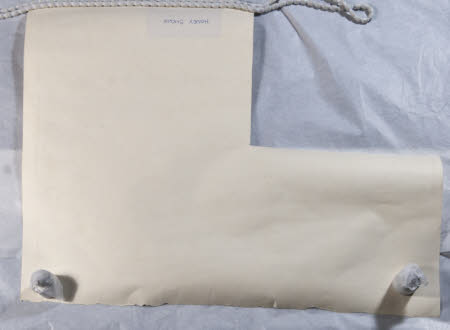Wallpaper sample
Morris & Co.
Category
Architecture / Features & Decoration
Date
Unknown
Materials
Order this imageCollection
Wightwick Manor, West Midlands
NT 1290767
Caption
May Morris wrote that ‘a belief in the power of beauty is a wholesome thing, and I make no apology for preaching it by the way. As an art, therefore, that should help to decorate home life very largely, and public life too … embroidery deserves to be taken seriously.’ Morris is best known for her work as a designer and maker of embroidery, but she excelled in many areas during her long career. Her principles were in accord with those of the Arts and Crafts movement, which valued traditional hand methods of manufacture over mechanisation, respecting the integrity of materials, taking inspiration from nature and avoiding excessive decorative embellishment. Morris became a central figure in the Arts & Crafts Exhibition Society, showing her work regularly and contributing to publications. She chose to specialise in embroidery as a student at the National Art Training School (later the Royal College of Art) in South Kensington. In 1885, aged 23, she took over the management of the embroidery division of her family’s business, Morris & Co., which she ran successfully for 11 years. Morris also taught embroidery at several art schools and studied, wrote and lectured in Britain and the USA on historical embroidery techniques – her particular passion – and on other aspects of the decorative arts. Her love of tradition is evident in a pair of dress sleeves in the collection at Wightwick Manor, West Midlands (NT 1289314); their spiralling stems and delicate flowers are inspired by 16th- and 17th-century embroidery. Morris also designed three wallpapers for Morris & Co., including one of its most successful papers, Honeysuckle, and designed and created many wonderful pieces of jewellery as an independent maker. In response to the exclusion of women from the Art Workers’ Guild (which did not admit women members until 1964), Morris founded the Women’s Guild of Arts in 1907. This society provided support, inspiration and camaraderie for women working independently in a wide variety of creative practices. Its first chair was Mary Seton Watts. Morris lived at Kelmscott Manor, Oxfordshire, with Mary Lobb (1878– 1939), with whom she had an enduring relationship. Morris’s impact on the Arts and Crafts movement and her ongoing legacy cannot be overstated.
Summary
Wallpaper samples, 'Honeysuckle' pattern (white background), designed by May Morris, 1883, originally printed by Jeffrey & Co for Morris & Co; two samples, marked as 33b (10 samples)
Makers and roles
Morris & Co., designer Morris & Co., maker
References
Conroy, Rachel, Women Artists and Designers at the National Trust, 2025, pp. 152-155

